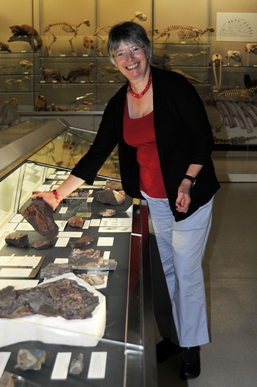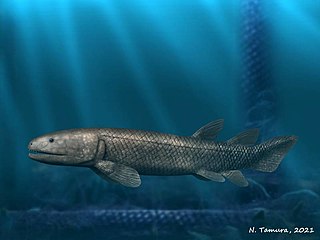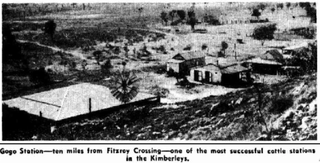
Gnathostomata are the jawed vertebrates. Gnathostome diversity comprises roughly 60,000 species, which accounts for 99% of all living vertebrates, including humans. In addition to opposing jaws, living gnathostomes have true teeth, paired appendages, the elastomeric protein of elastin, and a horizontal semicircular canal of the inner ear, along with physiological and cellular anatomical characters such as the myelin sheaths of neurons, and an adaptive immune system that has the discrete lymphoid organs of spleen and thymus, and uses V(D)J recombination to create antigen recognition sites, rather than using genetic recombination in the variable lymphocyte receptor gene.

Jennifer Alice Clack, was an English palaeontologist and evolutionary biologist. She specialised in the early evolution of tetrapods, specifically studying the "fish to tetrapod" transition: the origin, evolutionary development and radiation of early tetrapods and their relatives among the lobe-finned fishes. She is best known for her book Gaining Ground: the Origin and Early Evolution of Tetrapods, published in 2002 and written with the layperson in mind.

Placoderms are vertebrate animals of the class Placodermi, an extinct group of prehistoric fish known from Paleozoic fossils from the Silurian to the end of the Devonian period. While their endoskeletons are mainly cartilaginous, their head and thorax were covered by articulated armoured plates, and the rest of the body was scaled or naked depending on the species.

Dunkleosteus is an extinct genus of large arthrodire ("jointed-neck") fish that existed during the Late Devonian period, about 382–358 million years ago. It was a pelagic fish inhabiting open waters, and one of the first apex predators of any ecosystem.

Palaeospondylus is a fish-like fossil vertebrate. Its fossils are described from the Achanarras slate quarry in Caithness, Scotland.

Arthrodira is an order of extinct armored, jawed fishes of the class Placodermi that flourished in the Devonian period before their sudden extinction, surviving for about 50 million years and penetrating most marine ecological niches. Arthrodires were the largest and most diverse of all groups of placoderms.

Tiktaalik is a monospecific genus of extinct sarcopterygian from the Late Devonian Period, about 375 Mya, having many features akin to those of tetrapods. Tiktaalik is estimated to have had a total length of 1.25–2.75 metres (4.1–9.0 ft) based on various specimens.

Tetrapodomorpha is a clade of vertebrates consisting of tetrapods and their closest sarcopterygian relatives that are more closely related to living tetrapods than to living lungfish. Advanced forms transitional between fish and the early labyrinthodonts, such as Tiktaalik, have been referred to as "fishapods" by their discoverers, being half-fish, half-tetrapods, in appearance and limb morphology. The Tetrapodomorpha contains the crown group tetrapods and several groups of early stem tetrapods, which includes several groups of related lobe-finned fishes, collectively known as the osteolepiforms. The Tetrapodomorpha minus the crown group Tetrapoda are the stem Tetrapoda, a paraphyletic unit encompassing the fish to tetrapod transition.
Andreolepis is an extinct genus of prehistoric fish, which lived around 420 million years ago. It was described by Walter Gross in 1968 based on scales found in the Hemse Formation in Gotland, Sweden. It is placed in the monogeneric family Andreolepididae and is generally regarded as a primitive member of the class Actinopterygii based on its ganoid scale structure; however some new research regards it as a stem group of osteichthyans.

The Gogo Formation in the Kimberley region of Western Australia is a Lagerstätte that exhibits exceptional preservation of a Devonian reef community. The formation is named after Gogo Station, a cattle station where outcrops appear and fossils are often collected from, as is nearby Fossil Downs Station.

John Albert Long is an Australian paleontologist who is currently Strategic Professor in Palaeontology at Flinders University in Adelaide, South Australia. He was previously the Vice President of Research and Collections at the Natural History Museum of Los Angeles County. He is also an author of popular science books. His main area of research is on the fossil fish of the Late Devonian Gogo Formation from northern Western Australia. It has yielded many important insights into fish evolution, such as Gogonasus and Materpiscis, the later specimen being crucial to our understanding of the origins of vertebrate reproduction.

Elpistostegalia is a clade containing Panderichthys and all more derived tetrapodomorph taxa. The earliest elpistostegalians, combining fishlike and tetrapod-like characters, such as Tiktaalik, are sometimes called fishapods. Although historically Elpistostegalia was considered an order of prehistoric lobe-finned fishes, it was cladistically redefined to include tetrapods.

Incisoscutum is an extinct genus of arthrodire placoderm from the Early Frasnian Gogo Reef, from Late Devonian Australia. The genus contains two species I. ritchiei, named after Alex Ritchie, a palaeoichthyologist and senior fellow of the Australian Museum, and I. sarahae, named after Sarah Long, daughter of its discoverer and describer, John A. Long.

Entelognathus primordialis is an early placoderm from the late Silurian of Qujing, Yunnan, 419 million years ago.

Sam Giles is a palaeobiologist at the University of Birmingham. Her research combines modern imaging with fossils to understand the evolution of life, in particular that of early fish, and in 2015 "rewrote" the vertebrate family tree. She was a 2017 L'Oréal-UNESCO Rising Star and won the 2019 Geological Society of London Lyell Fund.

Bianchengichthys is a genus of maxillate placoderm fish from the late Silurian Period. Its fossils have been recovered from Yunnan Province, China, and it is represented by only one species: Bianchengichthys micros.
Compagopiscis is an extinct genus of placoderm known from the Gogo Formation. It lived in the Upper Devonian of Western Australia. The genus is monotypic, with its only species being Compagopiscis croucheri.

Qianodus is a jawed vertebrate genus that is based on disarticulated teeth from the lower Silurian of China. The type and only species of Qianodus, Q. duplicis, is known from compound dental elements called tooth whorls, each consisting of multiple tooth generations carried by a spiral-shaped base. The tooth whorls of Qianodus represent the oldest unequivocal remains of a toothed vertebrate, predating previously recorded occurrences by about 14 million years. The specimens attributed to the genus come from limestone conglomerate beds of the Rongxi Formation exposed near the village of Leijiatun, Guizhou Province, China. These horizons have been interpreted as tidal deposits1 that form part of the shallow marine sequences of the Rongxi Formation.
Min Zhu, is a Chinese paleontologist at the Institute of Vertebrate Paleontology and Paleoanthropology (IVPP), a CAS Member. He completed his undergraduate studies at Nanjing University and completed his PhD thesis at IVPP. He is currently leading a research team from IVPP. The latest findings from his team are unearthed from two new fossil depositories, shedding light on the rise of jawed vertebrates

The Mandagery Sandstone is a Late Devonian geological formation in New South Wales, Australia. It is one of several famed Australian lagerstätten, with thousands of exceptional fish fossils found at a site near the town of Canowindra.
















